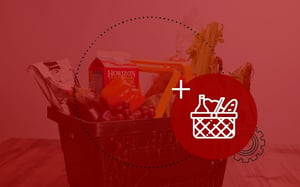The basket size of your average shopper can tell you a lot about your retail business. For one, the number of items they purchase can show you if you’re ranging the correct assortment of products. It can tell you if you satisfy their needs. More importantly, you’ll know if you’re meeting your overall goals.
For the sake of clarity, the goals we’re alluding to are the same for every retailer. They are to increase sales and profit and to please customers. That said, these goals are intrinsically linked to the size of your customers’ baskets at checkout.
Let us explain.
Your customers put more items into their baskets because you offer them the products they want and need. The obvious result is an increase in sales and overall profit for your business. Thus, when your shoppers arrive at the checkout counter with a fuller basket, you’ve effectively met your goals.
Of course, getting to this point isn't that simple. While you might stock the correct products for your target market, it doesn’t automatically mean they’ll buy more. You also need to implement specific tactics to persuade and encourage them to fill their baskets.
1. Spread your high-traffic categories out across your store
If you want to increase the size of your customers’ baskets, the simplest action to take is to expose them to more of your merchandise.
Fortunately, it’s easy enough to do this. You simply need to look at your high-trafficked categories - those products which are most frequently bought - and then spread them out strategically across your stores. Your store layout also plays a critical role in allowing you to spread out your categories.
Let’s say that you’re a convenience store with a Bakery sells bread and other confectionery items, for example. Now imagine you placed your Bakery at the front of your store. While you’re pulling customers in to buy bread and whatever else you stock at your bakery, you’re not giving them a reason to move further into your store. That’s not to say that shoppers won’t enter your store. Some will. But many won’t. They’ll buy their bread and then walk out.
However, if you place your Bakery at the back of your store, you’ll draw customers into and through your store. As a result, you ensure that your customers walk past categories and products they wouldn’t have otherwise seen.
When you remind your customers of what they may have forgotten, you stand a good chance at increasing their basket size. There is also the fact that by spreading your high-trafficked categories out, you entice your customers to spend more time in your store. That invariable leads to more money spent through larger basket sizes.
For example, upon arriving at your Bakery, a customer might already have taken a stroll through your store and filled their basket with their favorite spread, cereal, and sweets. Even if they haven’t, they may still add these products to their basket since they need to walk back past these aisles on their way to the checkout counter.
That said, there is another reason to implement this tactic in-store, and it goes beyond increasing your customers’ transaction size. By spreading out your high-trafficked categories, you can prevent floor congestion during peak shopping hours, thus pleasing your customers.
2. Include a loyalty programme and consider gamifying it
As the descriptor suggests, a loyalty programme is all about fostering customer loyalty and devotion. And there are many different variants.
The most common reward is accumulating points according to how much money you’ve spent. The other prize is either a direct discount of a specific percentage on the presentation of a card when purchasing or a discount on your next purchase. Either way, loyalty programmes are designed to offer value and show appreciation to customers.
That said, there is also an opportunity to take the stock standard loyalty programme and gamify it. Pick n Pay’s Stikeez and Checkers’ Little Shop collectibles are just two of many examples. Little Shop collectibles goes back to 2013 when New World wanted to celebrate its 50th anniversary.
What makes them so special is that these kinds of promotions are perfect motivators to encourage your customers to increase their basket size since they’ll receive a gift in return. As soon as you gamify it, you’re increasing its value. More than that, you're changing how your customers view their purchases. They have another reason for filling their basket.
There are stories of customers buying more to qualify for a reward. For the sake of clarity, you could get one free for every R150 spent in-store.
As a result, in 2015, Stikeez helped Pick n Pay raise its turnover by 8.5% in six months. Meanwhile, Checkers’ Little Shop collectibles has become more popular than anyone expected, spawning a website where you can trade these souvenirs.
There is also the point that adding play into a loyalty strategy can lead to better customer experiences.
The more value you provide your customers, the more often they’ll return to your store.
3. Include promotions in-store to build excitement
It goes without saying: promotions are a great opportunity to build excitement amongst your customers. More than that, they can go a long way to entice them to increase their basket size.
The reason for that is simple: promotions work in such a way as to entice your customers to consider buying more than they had initially wanted or planned to.
Let’s take the example of a ‘three for the price of two’ special you might find in Store A. When customers walk into this store, they most probably have a shopping list. If not a list, they’ll have an idea of what they intend to buy and intend to stick to it. However, as soon as they see the special - and hopefully the store manager has made it highly visible - a thought is placed in their mind.
Should they buy it? If the promotion is enticing enough, they’ll take up the offer. If there is a series of specials promoting all sorts of products, before they know it, they will have an additional two to five products in their basket.
Learn how our planogram software can help you choose the right products and categories to promote
Another example is the tasting sample promotion table that you can install at the end of an aisle. Ideal for a new product launch, you’re allowing your customers to taste the product without committing to a purchase. Once your customers taste the product, there is every chance they’ll make a purchasing decision on the spot.
In that sense, promotions are also a good source of impulse purchases.
4. Cross-merchandise complementary products
When laying out your products in-store, a key factor to consider is shopability. In short, are you creating a pleasant shopping experience for your customers.
One way of doing that is to cross-merchandise similar products. We’ve touched on the topic of cross-merchandising often on this blog. Throughout these pieces runs a common theme - it’s the perfect opportunity to increase your customer's basket size.
Let's use the Bakery example that we used previously in this piece. If you’ve employed the tactic of cross merchandising, your customers are likely to find complementary products either directly next to, or near your Bakery. Spreads are a typical example here. It could even be worth placing a refrigerated area next to the Bakery with a selection of Cold Meats and Cheeses. A small fridge nearby with Butter and Margarine could work just as well.
In cross-merchandising complimentary products, you create mental cues for your customers that trigger their decision-making process. Another example would be placing Chips next to your Cold Drinks or Chewing Gum near your Cigarettes. You could even place a mouthwash stand next to foodstuffs that cause bad breath.
Just a note of warning here. You shouldn’t cross-merchandise for the sake of cross-merchandising; it can go wrong. More importantly, it will have the opposite effect to what you intended. Instead of encouraging your customers to buy more, it will frustrate them.
For example, placing your coffee products next to your toilet paper is a terrible idea. What is the benefit of doing that? It will only confuse and frustrate your customer and interrupt their shopping experience.


